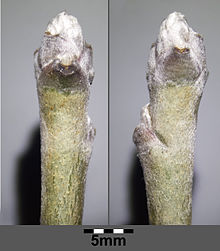Common laburnum
| Common laburnum | ||||||||||||
|---|---|---|---|---|---|---|---|---|---|---|---|---|

Common laburnum ( Laburnum anagyroides ) |
||||||||||||
| Systematics | ||||||||||||
|
||||||||||||
| Scientific name | ||||||||||||
| Laburnum anagyroides | ||||||||||||
| Medic. |
The Common Goldregen ( Laburnum anagyroides ), also Common laburnum called, is a plant from the genus Goldregen ( Laburnum ). It's poisonous.
description
Vegetative characteristics
The common laburnum grows as a deciduous shrub or small tree and reaches heights of up to 7 meters. The green, alternate arranged leaves are divided into petiole and leaf blade. The petiole is hairy densely pressed. The leaf blade is threefold fingered .
Generative characteristics
The flowering period extends from April to June. There are many flowers in hanging, racemose . The flowers are zygomorphic with five-fold with a double flower envelope . The five petals are yellow.
The legumes are elongated. The bean-shaped seeds are about 3 millimeters in size.
The number of chromosomes is 2n = 48.
ecology
The common laburnum is only 20 to 30 years old. The branches are surrounded by a layer of cork as a periderm ; no bark is formed. VA mycorrhiza is present and atmospheric nitrogen is assimilated in root nodules .
From an ecological point of view, these are odorless "pollen butterfly flowers" with a folding mechanism . Since no nectar is offered, the stamens have grown together to form a tube; but the flowers have a fabric that can be pierced. In the hanging grapes, the flowers only reach a horizontal position by turning ( resupination ). Pollinators are bees and beetles .
The legumes jump in drought, i. H. xerochas , up and spreading their seeds as self-spreaders. Their spread is several meters; they are winter dwellers . The roll seeds have fatty oil as a nutrient reserve. The fruit ripeness extends from August to September.
Occurrence
Laburnum anagyroides occurs in southern Central and Eastern Europe . It thrives in southeastern Europe in the Orno-Ostryetum plant community and occurs in Central Europe mainly in the Quercetum pubescenti-petraeae.
Toxicity
All parts of the golden rain plant are very poisonous, especially the seeds. The seeds contain up to 3 percent of the highly poisonous quinolizidine alkaloid cytisine , the flowers contain around 1 percent of the toxin, and the leaves contain around 0.5 percent cytisine. The salary can vary according to the season. In addition to the main alkaloid cytisine, N-methylcytisine and pyrrolizidine alkaloids such as. B. Laburnin detected. For humans, 3 to 4 unripe legumes, 15 to 20 seeds or 10 flowers are fatal.
In the case of poisoning with laburnum, a central excitation occurs similar to that of nicotine . This later changes into a dampening of the CNS and the sympathetic nervous system . Symptoms include nausea, salivation , stomach pain, and sweats. It often happens very quickly after oral intake to violent vomiting. Therefore, fatal poisoning is rare. If vomiting does not take place, death occurs through respiratory paralysis after violent convulsions which turn into paralysis.
Because of its nicotine-like effects, cytisine is used for smoking cessation .
Systematics
The first publication of Laburnum anagyroides Medik. took place in 1787 by Friedrich Kasimir Medikus in lectures at the Churpfälzische Physikalisch-Ökonomischen Gesellschaft. Heidelberg 2, page 363. Synonyms for Laburnum anagyroides Medik. are: Cytisus laburnum L. and Laburnum vulgare Bercht. et JSPresl .
use
The common laburnum is often used as an ornamental shrub .
A few varieties were bred, here is a selection: 'Aureum', 'Bullatum', 'Carlieri', 'Chrysophyllum', 'Incisum', 'Pendulum', 'Quercifolium', 'Serotinum', 'Sessilifolium', 'Variegatum'
Common names
The other common German-language names for the common laburnum exist or existed : Gäli Akazie ( Switzerland ), Baumbonen, Bohnenbaum, Falscher Ebenbaum, Deutscher Ebenbaum, Goldregen (Switzerland, East Friesland ), Hosen and Schoontjes (East Friesland), Kleebaum and Markweiden.
literature
- Ruprecht Düll , Herfried Kutzelnigg : Pocket dictionary of plants in Germany and neighboring countries. The most common Central European species in portrait . 7th, corrected and enlarged edition. Quelle & Meyer, Wiebelsheim 2011, ISBN 978-3-494-01424-1 .
- Roth / Daunderer / Kormann: Poisonous plants, plant poisons. 4th edition.
- Ingrid and Peter Schönfelder : The new manual of medicinal plants , Franckh-Kosmos Verlagsgesellschaft, 2011, ISBN 3-440-09387-5 .
Web links
- Laburnum anagyroid medic., Common laburnum. In: FloraWeb.de.
- Common laburnum . In: BiolFlor, the database of biological-ecological characteristics of the flora of Germany.
- Profile and distribution map for Bavaria . In: Botanical Information Hub of Bavaria .
- Laburnum anagyroid medic. In: Info Flora , the national data and information center for Swiss flora . Retrieved November 12, 2015.
- Thomas Meyer: Data sheet with identification key and photos at Flora-de: Flora von Deutschland (old name of the website: Flowers in Swabia ).
- Laburnum - poisonous plant of the year 2012.
Individual evidence
- ↑ a b Erich Oberdorfer : Plant-sociological excursion flora for Germany and neighboring areas . With the collaboration of Angelika Schwabe and Theo Müller. 8th, heavily revised and expanded edition. Eugen Ulmer, Stuttgart (Hohenheim) 2001, ISBN 3-8001-3131-5 , pp. 580 .
- ↑ Nature Lexicon Laburnum Retrieved July 28, 2010.
- ^ A b T. Dingermann, K. Hiller, G. Schneider, I. Zündorf: Schneider drug drugs . 5th edition, Elsevier 2004, ISBN 3-8274-1481-4 , p. 441.
- ↑ Common laburnum (Laburnum anagyroides) at giftpflanze.com. Retrieved June 26, 2014 .
- ↑ a b E. Teuscher: Biogenic medicines. 5th edition. Wissenschaftliche Verlagsgesellschaft, 1997. ISBN 3-8047-1482-X . P. 356.
- ↑ Laburnum anagyroides in the Germplasm Resources Information Network (GRIN), USDA , ARS , National Genetic Resources Program. National Germplasm Resources Laboratory, Beltsville, Maryland.
- ↑ SysTax database. In: Ulm University.
- ^ Georg August Pritzel , Carl Jessen : The German folk names of plants. New contribution to the German linguistic treasure. Philipp Cohen, Hannover 1882, p. 126. ( online ).



